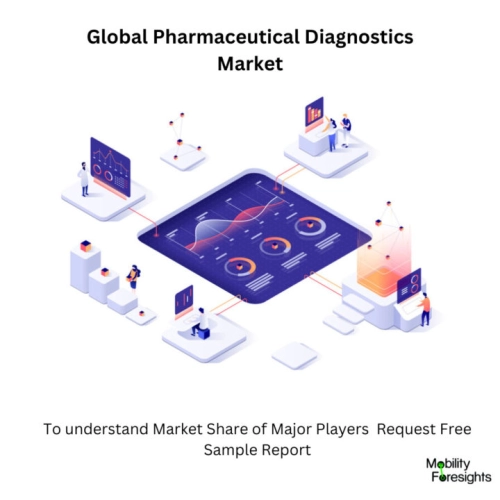
- Get in Touch with Us

Last Updated: Apr 25, 2025 | Study Period: 2024-2030
Pharmaceutical diagnostics, sometimes referred to as medical diagnostics or in vitro diagnostics (IVD), is the use of diagnostic tests and methods to establish the existence, absence, or stage of a disease or condition as well as to track the efficacy of therapies.
These diagnostics are essential to the provision of healthcare because they help in the fast and correct diagnosis of diseases, the formulation of treatment plans, and the evaluation of patient response to therapy.
Pharmaceutical diagnostics include a broad range of procedures, tools, and techniques that are applied in a variety of contexts, including clinics, hospitals, laboratories, and even at-home testing kits.
These diagnostic procedures could entail measuring and detecting particular markers, chemicals, or genetic information indicative of a particular disease or condition using samples of blood, urine, tissue, or genetic material.
Recent years have seen major breakthroughs in the field of pharmaceutical diagnostics, thanks to discoveries in molecular biology, genomics, proteomics, and nanotechnology. These developments have produced quicker, more precise, sensitive diagnostic techniques that allow for earlier and more accurate illness identification.
Infectious diseases, cancer, cardiovascular diseases, neurology, genetic disorders, and autoimmune diseases are just a few of the medical disciplines that use pharmaceutical diagnostics.
They support the diagnosis of diseases like cancer, HIV/AIDS, diabetes, genetic disorders, and STIs in addition to monitoring therapeutic interventions and screening populations at risk.
Pharmaceutical diagnostics are useful for diagnosis, but they also have a place in personalised medicine, which allows for more individualised and efficient therapies by tailoring treatments to a patient's genetic profile.
As part of precision medicine, medicines are tailored to a patient's unique traits, including genetic make-up and molecular profiles, thanks to these diagnostics.
Overall, pharmaceutical diagnostics are an essential component of modern healthcare, enabling early disease detection, accurate diagnosis, treatment optimization, and improved patient care.
Continued research, development, and innovation in this field hold the promise of further advancing healthcare by providing more efficient, precise, and personalised diagnostic solutions.

Theglobal pharmaceutical diagnostics marketaccounted for $XX Billion in 2022 and is anticipated to reach $XX Billion by 2030, registering a CAGR of XX% from 2024 to 2030.
The term "IVD products" refers to a broad range of diagnostic procedures carried out on biological samples taken from patients.
Tests for blood, urine, saliva, and other body fluids are among them. Various problems, including infections, cancer markers, hormone levels, and autoimmune diseases, can be found using IVD products.
Diagnostic software and algorithms are increasingly and more common as technology advances. To assist in disease diagnosis and treatment choices, these technologies analyse patient data including clinical information, laboratory results, and medical imaging.
| Sl no | Topic |
| 1 | Market Segmentation |
| 2 | Scope of the report |
| 3 | Abbreviations |
| 4 | Research Methodology |
| 5 | Executive Summary |
| 6 | Introduction |
| 7 | Insights from Industry stakeholders |
| 8 | Cost breakdown of Product by sub-components and average profit margin |
| 9 | Disruptive innovation in the Industry |
| 10 | Technology trends in the Industry |
| 11 | Consumer trends in the industry |
| 12 | Recent Production Milestones |
| 13 | Component Manufacturing in US, EU and China |
| 14 | COVID-19 impact on overall market |
| 15 | COVID-19 impact on Production of components |
| 16 | COVID-19 impact on Point of sale |
| 17 | Market Segmentation, Dynamics and Forecast by Geography, 2024-2030 |
| 18 | Market Segmentation, Dynamics and Forecast by Product Type, 2024-2030 |
| 19 | Market Segmentation, Dynamics and Forecast by Application, 2024-2030 |
| 20 | Market Segmentation, Dynamics and Forecast by End use, 2024-2030 |
| 21 | Product installation rate by OEM, 2023 |
| 22 | Incline/Decline in Average B-2-B selling price in past 5 years |
| 23 | Competition from substitute products |
| 24 | Gross margin and average profitability of suppliers |
| 25 | New product development in past 12 months |
| 26 | M&A in past 12 months |
| 27 | Growth strategy of leading players |
| 28 | Market share of vendors, 2023 |
| 29 | Company Profiles |
| 30 | Unmet needs and opportunity for new suppliers |
| 31 | Conclusion |
| 32 | Appendix |